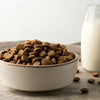Enhancing Your Dog's Diet: What Can I Mix With My Dry Dog Food?
- Houndsy
Table of Contents
- Introduction
- Understanding Your Dog’s Nutritional Needs
- Top Ingredients to Mix with Dry Dog Food
- Guidelines for Mixing Foods
- How Houndsy Elevates the Feeding Experience
- Conclusion
Introduction
Have you ever watched your dog turn their nose up at kibble, leaving you wondering how to entice them back to their bowl? You're not alone! According to recent studies, approximately 40% of dog owners report that their pets are picky eaters at some point in their lives. The good news is that there are numerous ways to revitalize your dog’s meals. This blog post will explore a variety of nutritious and delicious options to mix with dry dog food, ensuring your furry friend enjoys every bite while receiving the essential nutrients they need.
By the end of this article, we will provide you with a comprehensive list of ingredients to consider, along with tips on how to safely incorporate them into your dog's diet. We will also discuss the importance of maintaining a balanced diet, ensuring that any additions complement your dog’s nutritional needs without disrupting their overall health. As we dive into this topic, we encourage you to reflect on your own feeding routines and consider how these suggestions might enrich your dog’s mealtime experience.
Ultimately, our mission at Houndsy is to enhance the everyday experience of pet owners and their beloved pets. By providing insights into what you can mix with dry dog food, we hope to simplify and elevate your dog feeding experience.
Understanding Your Dog’s Nutritional Needs
Before we jump into the mix-ins, it's essential to understand your dog’s basic nutritional requirements. Dogs are omnivores, meaning they thrive on a balanced diet that includes proteins, fats, carbohydrates, vitamins, and minerals. High-quality dry dog food is formulated to provide a complete diet, but adding variety can enhance taste and nutrition.
- Protein: Dogs need protein for muscle development and repair. It also supports a healthy immune system.
- Fat: Healthy fats provide energy and support skin and coat health.
- Carbohydrates: While not essential, carbohydrates supply energy and can be a source of fiber.
- Vitamins and Minerals: These are crucial for various bodily functions and overall health.
When incorporating new ingredients, it's vital to ensure that they do not exceed 10% of your dog’s daily caloric intake. This way, you can maintain a balanced diet while adding excitement to mealtimes.
Top Ingredients to Mix with Dry Dog Food
1. Wet Dog Food
Adding wet dog food to dry kibble is one of the simplest ways to enhance palatability. The moisture can make the meal more appealing and provide additional nutrients and protein.
- Benefits: Increased moisture content, enhanced flavor, and added nutrients.
- How to Use: Mix a few spoonfuls of wet food into dry kibble before serving.
2. Canned Pumpkin
Canned pumpkin (not the spiced pie filling) is an excellent source of fiber and can aid in digestion.
- Benefits: Promotes digestive health and adds moisture.
- How to Use: Start with a teaspoon for small dogs and increase as tolerated.
3. Peanut Butter
Most dogs love the taste of peanut butter, which is high in protein and healthy fats.
- Benefits: Provides energy and can make dry food more enticing.
- How to Use: Mix a small amount (ensuring it’s xylitol-free) into the kibble or serve it as a treat.
4. Cooked Chicken or Turkey
Lean meats like chicken or turkey are packed with protein and can transform an ordinary meal into a gourmet feast for your pup.
- Benefits: High in protein, easy to digest.
- How to Use: Shred or chop into small pieces and mix with dry food.
5. Broth
A splash of low-sodium chicken or beef broth can add flavor and moisture to dry kibble.
- Benefits: Enhances taste and increases hydration.
- How to Use: Pour a small amount over the kibble before serving; ensure it does not contain onions or garlic.
6. Eggs
Eggs are a powerhouse of nutrients, offering protein and essential fatty acids.
- Benefits: Rich in protein and biotin for a healthy coat.
- How to Use: Serve cooked or raw (ensure they are pasteurized) with kibble.
7. Sweet Potatoes
Cooked sweet potatoes are a nutritious addition that provides fiber and vitamins.
- Benefits: Rich in antioxidants and vitamins.
- How to Use: Mash or cut into small pieces and mix with kibble.
8. Vegetables
Vegetables like carrots, green beans, and peas can add fiber and nutrients.
- Benefits: Low-calorie and rich in vitamins.
- How to Use: Serve raw, cooked, or pureed, depending on your dog’s preference.
9. Fruits
Certain fruits can be a delicious and healthy treat. Apples, blueberries, and bananas are great options.
- Benefits: Provide vitamins, antioxidants, and a touch of sweetness.
- How to Use: Chop into small pieces and mix with kibble; avoid toxic fruits like grapes.
10. Yogurt
Plain, unsweetened yogurt is a good source of probiotics, beneficial for gut health.
- Benefits: Aids digestion and adds creaminess to meals.
- How to Use: Mix in a spoonful with kibble.
11. Commercial Dog Food Toppers
These products are designed to enhance dry food and often come in various flavors and formulations.
- Benefits: Convenient and specifically formulated for dogs.
- How to Use: Follow the manufacturer's serving suggestions.
12. Cottage Cheese
Cottage cheese is another dairy option that can provide protein and calcium.
- Benefits: Low in fat and high in protein.
- How to Use: Offer in moderation, especially if your dog is lactose intolerant.
13. Fish
Fish like salmon or sardines are excellent sources of omega-3 fatty acids.
- Benefits: Supports skin and coat health.
- How to Use: Use canned fish in water or cooked fish, ensuring no bones are present.
14. Flaxseed Oil or Coconut Oil
These oils can be a healthy addition, providing essential fatty acids.
- Benefits: Supports a healthy coat and skin.
- How to Use: Add a few drops to the kibble.
15. Liver or Other Organ Meats
Liver is packed with vitamins and minerals.
- Benefits: Nutrient-dense and flavorful.
- How to Use: Cook thoroughly and chop into small pieces before mixing.
Guidelines for Mixing Foods
While it’s tempting to add multiple ingredients to your dog’s meals, moderation and caution are key. Here are some guidelines to follow:
- Start Small: Introduce new mix-ins gradually to avoid digestive upset.
- Monitor Reactions: Keep an eye on your dog’s stool and overall health when introducing new foods.
- Avoid Toxic Foods: Steer clear of foods that are toxic to dogs, such as chocolate, onions, garlic, grapes, and raisins.
- Consult Your Veterinarian: If you have concerns about your dog’s specific dietary needs, always consult with a veterinarian.
How Houndsy Elevates the Feeding Experience
At Houndsy, we believe that feeding time should be a joyful experience not just for dogs but also for their owners. That’s why we designed the Houndsy Kibble Dispenser, a product that combines functionality with style. Our dispenser allows for perfect portion control, ensuring your dog gets the right amount of food every time without the mess.
With its mid-century modern design, the Houndsy Kibble Dispenser seamlessly fits into any home decor, making feeding time a beautiful part of your routine. Plus, it stands at a convenient height, eliminating the need for bending over, which is a lifesaver for many pet parents. We invite you to explore our Houndsy Kibble Dispenser and elevate your dog's feeding experience today!
Conclusion
Mixing ingredients with your dog’s dry food can not only enhance their meal experience but also provide essential nutrients to support their health. As we’ve outlined, there are numerous options available, from protein-rich meats to fiber-packed vegetables and fruits. The key is to maintain balance and moderation while introducing variety.
We encourage you to consider your dog’s preferences and nutritional needs as you explore these additions. With the right mix-ins, you can transform mealtime into a delightful event. And remember, the Houndsy Kibble Dispenser is here to ensure that your feeding routine remains convenient and stylish.
FAQ
Q: Can I mix different brands of dog food?
A: Yes, but it’s best to gradually introduce new brands to avoid digestive upset. Ensure that both foods are of high quality and meet your dog’s nutritional needs.
Q: How often should I change my dog’s food mix-ins?
A: You can change mix-ins regularly to keep meals interesting, but monitor your dog’s tolerance to new ingredients.
Q: Are there any foods I should avoid mixing with dry dog food?
A: Yes, avoid toxic foods like chocolate, grapes, onions, and garlic. Always check with your veterinarian if you’re unsure about specific ingredients.
Q: How can I tell if my dog is allergic to a new ingredient?
A: Watch for signs such as itching, vomiting, or changes in stool. If you notice any unusual symptoms, consult your veterinarian immediately.
Q: How can Houndsy products assist with feeding?
A: Our Houndsy Kibble Dispenser offers a stylish and functional way to serve meals while ensuring perfect portion control, making feeding time easier and more enjoyable for both you and your dog. Explore our Houndsy Kibble Dispenser to learn more!












